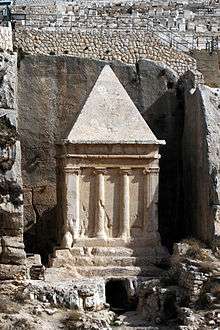Tomb of Zechariah

The Tomb of Zechariah is an ancient stone monument adjacent to the Tomb of Benei Hezir.
Architectural description
The monument is a monolith—it is completely carved out of the solid rock and does not contain a burial chamber. The lowest part of the monument is a crepidoma, a base made of three steps. Above it there is a stylobate, upon which there is a decoration of two ionic columns between two half ionic columns and at the corners there are two pilasters. The capitals are of the Ionic order and are decorated with the egg-and-dart decoration. The upper part of the monument is an Egyptian-style cornice upon which sits a pyramid. Interestingly the fine masonry and decoration that is visible on the western side, the facade, is on the western side alone. On the other sides of the tomb the work is extremely rough and unfinished; it seems as if the work was abruptly stopped before the artists could finish the job.
Identification of the tomb
According to a Jewish tradition, which is first suggested by the 1215 CE writings of Menahem haHebroni, this is the tomb of the priest Zechariah Ben Jehoiada, a figure that the Book of Chronicles records to have been stoned:
- And the Spirit of God came upon Zechariah the son of Jehoiada the priest, which stood above the people, and said unto them, Thus saith God, Why transgress ye the commandments of the Lord, that ye cannot prosper? because ye have forsaken the Lord, he hath also forsaken you. And they conspired against him, and stoned him with stones at the commandment of the king in the court of the house of the Lord[1]
There is no documentary evidence as to where he was buried, and the tomb does not contain a body as it is a solid object carved from the rock.[2]
The style of the construction, which includes Hellenic details such as Ionic columns, is similar to that of the Tomb of Benei Hezir, and several writers think that they are near-contemporary with one another; scholars specialising in funerary practices and monuments have ascribed a first-century CE date to the Tomb of Zechariah,[3] making it impossible to be the tomb of the 7th/8th/9th century BCE[4] Zechariah ben Jehoiada. It has been proposed that the Tomb of Zechariah is actually the nefesh (a Jewish funerary monument similar to the Greek stele) for the Tomb of Benei Hezir,[5] which is accessed from a rock-cut passage adjacent to the monument, and which states that it has an adjacent magnificent structure, an item not otherwise identified.
See also
References
- ↑ 2 Chronicles 24:20-21
- ↑ Rachel Hachlili, Jewish funerary customs, practices and rites in the Second Temple period (2005), page 132
- ↑ Rachel Hachlili, Jewish funerary customs, practices and rites in the Second Temple period (2005), page 30
- ↑ the dating of the early Judean kingdom is controversial
- ↑ Samuel Rocca, Herod's Judaea, (2008), page 365
| Wikimedia Commons has media related to Tomb of Zechariah. |
Coordinates: 31°46′34.45″N 35°14′20.83″E / 31.7762361°N 35.2391194°E